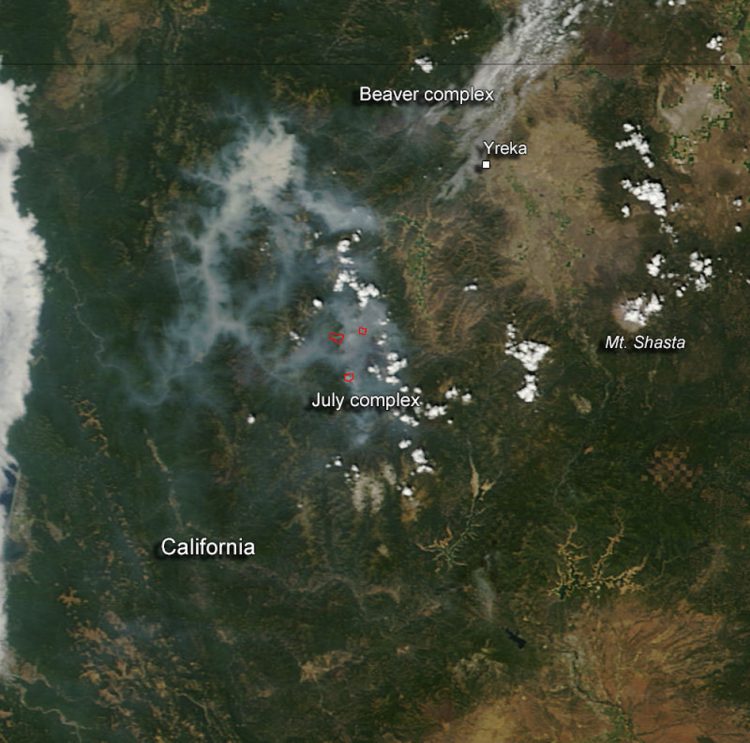Beaver Complex and July Complex Wildfires in California

After it was first discovered on July 31, the Oregon Gulch Fire rapidly moved southeast from the Cascade Siskiyou National Monument into the Soda Mountain Wilderness Area, from Jackson County into Klamath County, and then into California.
To date 35,302 acres have been affected. The wildfire complex is currently 100% contained. Per the Inciweb site total cost of this complex of fires is $20,311,646 for the Oregon Gulch Fire and $1,909,191 for the California fire. The Oregon Gulch fire burned 25,683 acres in Oregon and moved into California where it burned 9,464 acres.
It is now 100% contained. The Salt Creek fire is 155 acres and is 100% contained. In this image, smoke still rises from several areas toward the top of the image, but it is thin and hazy. No hot spots (indicated by red dots) were found by the Moderate Resolution Imaging Spectroradiometer (MODIS) instrument so the smoke could be just the smoldering aftermath.
The July complex consists of the Whites, Man, Leef, and Rays incidents. The Log fire is being managed in conjunction with the July Complex and is the number one priority. The Log fire is located just north of the July complex and is obscured in this image by the smoke and clouds. The Leef fire is 100% contained and in patrol status, the Rays fire is 100% contained at 21 acres and in patrol status. The Man Fire is 415 acres and is 0% contained. Resources on the Whites fire have completed 16.5 miles of direct and indirect line of which 6.5 miles have been contained.
- Whites Fire: 30,530 acres 18% contained
- Log Fire: 3,629 acres 95% contained
- Man Fire: 415 acres 0% contained
- Leef Fire: 17 acres 100% contained
Moderate fire behavior occurred over much of the fire area today (08/20) as a result of light winds combined with a smoke cap. The relative humidity is above the threshold for significant fire behavior. On slopes that were aligned with the wind, there was short range spotting, uphill runs and group torching.
This natural-color satellite image was collected by MODIS aboard the Terra satellite on August 19, 2014. Actively burning areas, detected by MODIS’s thermal bands, are outlined in red.
NASA image courtesy Jeff Schmaltz, MODIS Rapid Response Team. Caption: NASA/Goddard, Lynn Jenner with information from Inciweb
Media Contact
All latest news from the category: Earth Sciences
Earth Sciences (also referred to as Geosciences), which deals with basic issues surrounding our planet, plays a vital role in the area of energy and raw materials supply.
Earth Sciences comprises subjects such as geology, geography, geological informatics, paleontology, mineralogy, petrography, crystallography, geophysics, geodesy, glaciology, cartography, photogrammetry, meteorology and seismology, early-warning systems, earthquake research and polar research.
Newest articles

Superradiant atoms could push the boundaries of how precisely time can be measured
Superradiant atoms can help us measure time more precisely than ever. In a new study, researchers from the University of Copenhagen present a new method for measuring the time interval,…

Ion thermoelectric conversion devices for near room temperature
The electrode sheet of the thermoelectric device consists of ionic hydrogel, which is sandwiched between the electrodes to form, and the Prussian blue on the electrode undergoes a redox reaction…

Zap Energy achieves 37-million-degree temperatures in a compact device
New publication reports record electron temperatures for a small-scale, sheared-flow-stabilized Z-pinch fusion device. In the nine decades since humans first produced fusion reactions, only a few fusion technologies have demonstrated…





















